[truax.org]>[Terry]>[Activity
Log]
Terry & Laura's Trip to the Pacific Northwest in the Summer of
2010
Without Kids
Diving In Cold Water
Vancover Island, British Columbia
August 10, 2010
For the first time in about 7 years, Laura and I have taken a trip by
ourselves. (Sumner ditched us for the summer and is now migrating for a
week, we're told, across the Northeast feeding off the good graces of friends,
cousins, and aunts & uncles; and Porter and Burnley are in Costa Rica on a
church mission trip). In a very last minute move, we decided to head to
the Pacific Northwest (Richard & Sally's backyard), specifically to Vancouver
Island. We stayed in a in small place near Brentwood Bay, on the east side
of Vancouver Island. Pretty awesome, as the photo taken from the
porch outside the room will attest to (taken at low tide).
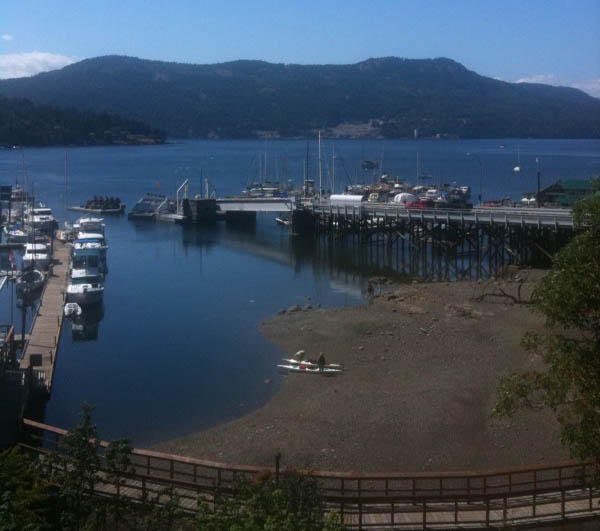 One of the reasons we chose this place is that they promote their scuba
diving program. That's right, scuba diving in the Pacific Northwest.
As a kid from Florida, there's a certain cognitive dissonance to the idea of
jumping in water in places where it snows in the winter -- for example, we don't
dive in Chicago. But, hey, we're adventurous so we figured we'd give it a
shot.
One of the reasons we chose this place is that they promote their scuba
diving program. That's right, scuba diving in the Pacific Northwest.
As a kid from Florida, there's a certain cognitive dissonance to the idea of
jumping in water in places where it snows in the winter -- for example, we don't
dive in Chicago. But, hey, we're adventurous so we figured we'd give it a
shot.
Since I can't find my dive log, I'm using this email as my log. Read
along if interested.
August 10, 2010. Saanich Inlet, McKinley's corner at Squally Reach,
Vancouver Island, British Columbia. Beautiful setting. Although it's a
bay, it feels like an alpine lake with fur covered mountains surrounding the
bay. Not a lot of boat traffic. Flat as can be. Bright sun.
Temps above the water felt about 72 degrees, and even warmer in the direct sun.
Temps in the water are a different story. Before we got on the boat, I
was thinking 60s perhaps. Not even close. I was told the water was
exceptionally "warm" this time of year. "Almost balmy." "Might be as
warm as 54 degrees today," the dive master pronounced. Laura's mouth
dropped and then stammered out, "don't people die of hypothermia at the
temperature." Answer: "Yes, that's why you'll wear a lot of neoprene
(i.e., wet suits)."
The wet suits were an ordeal. Most people who dive in cold water use a
dry suit, which is a lot more comfortable to dive in (it literally keeps you
dry, and importantly warm), but there's some additional skill involved because
of issues with buoyancy, etc. Since we were only diving a few times, the
dive instructor said confidently, "really, the wet suits will be fine, and it
will be a lot easier." We took her advice. (In retrospect, I think
she understood that Florida-bred divers aren't repeat customers).
What that meant was putting on "layers" of wet suit. We started with
the basic suit -- thick as could be. Then the boots, then the hood, which
was tucked under the first suit, then the next layer on top of the other suit,
and then the gloves. We looked -- and certainly felt like -- overstuffed
blubber masses. Then, after having squeezed and tugged our way into the
wet suits, we then had the fun "weighting up." Given that we had covered
ourselves in so much neoprene, we needed lots more weight to make sure we could
get under the water. I had to add 36 pounds (normally I dive with 8
pounds) to my BC pack. (Laura, more svelte then me, of course, only needed
to add 34). That's a lot of weight. Then, a backward flip into the
water, and the feeling of being a "bobbing cork." The little bit of water
that made it's way through the layers of wet suit was, well, "cold." But
manageable at first. We did a buoyancy check -- in other words, we needed
to test whether we would we sink. Laura was okay, but amazingly, I needed
more weight, so they threw another few pounds onto my tank. Up to 38.
We then dropped down, first to about 25 feet, and then eventually to 65 feet.
Visibility (bright, clear sunny day up top), was about 50 feet (maybe) (as
compared to 100+ in the Caribbean). Not much color. Lots of kelp.
Many different varieties of shrimp. And some very interesting mollusk-like
creatures known as nudibranches.
http://en.wikipedia.org/wiki/Nudibranch. Huge jelly fish on the first
dive with very long tentacles, the kind that sting and leave a mark for a while.
We stayed clear of those, but they were beautiful to look at. Saw a very
large octopus (squid) in a cave/rock. Could only see one eye and many of
the long tentacles. Interestingly, we also saw the food debris leading up
to his/her abode. Lots of emptied crab shells lining the doorway to the
cave. Laura later remarked that it reminded her of the story of the
Minotaur. Lots of other crab life, and other small animal life.
Schools of little (very little) minnows that almost created a cloud under water.
But, no large fish. Biggest fish was some rock fish. We looked for a
"wolf fish", which apparently can get up to 40 to 50 pounds, but we didn't' see
one.
After about 40 minutes, it was starting to get cold. Very cold.
We persevered for another 15 minutes, and at about 55 minutes (actually 58), we
came to the surface, bobbing again like corks. We managed our way --
weight and all -- into the boat, shivering. When we hit the surface, the
world turned colorful again on a bright, beautiful sunny day (which is not the
experience I have when diving in the Caribbean, where the world underneath is
more colorful in many ways than the world above.
We shivered some more, warmed up, and then moved dive spots closer to
Brentwood Bay. This was a shallower dive and we were looking for squid.
Laura, the total trooper, decided she would go down again. So, the same
routine -- we "blubbered up" with all the neoprene. This time, the dive
started by dropping down through about 15 feet of very dense school of "moon
beam" jelly fish. It was magical falling through them. Very
hypnotic. I found myself losing my sense of up/down while watching them.
Then back down to 50+ feet. This dive felt colder. Interesting
walls, some crab life, lots of kelp, some coral crustaceans, but no soft coral.
And cold, cold, cold. After about 45 minutes, we had had enough, and
surfaced, again through the layers of jelly fish, and managed our way back into
the boat.
Biggest challenge was diving with all the weight and neoprene. As the
tank emptied, buoyancy became more difficult. Other challenge was the
cold. If we were to do again, we'd train for the dry suits. I had planned
to dive one more day, but after the two dives, I had seen enough, and, have had
my fill of "cold water diving". Next year, it's back to the warm water.
Terry --
2nd email dated 8/15/10
I won't burden you with lots of emails about our trip. I know it's kind
of like watching home movies. But, I thought you might still enjoy the
short note/reflection below.
On our way home to Chicago from Vancouver Island, we stopped in Seattle for a
few days. Very cool trip from Victoria to Seattle by Sea Plane (I'll
debrief with you dad later), landing in Lake Union in what seemed to be a "get
out of way, here we come" approach to the boaters below.
I know Seattle has a reputation for lots of rain/drizzle. Although that
reputation must be well earned, given all the snow that still sits on top of the
Olympic Mountains, (even though they are only 1000 to 1500 feet higher than
Grandfather Mountain), it's apparently actually a fairly dry region in the
summer, particularly in August. Everyday in Victoria, and each of our days
in Seattle has been spectacular. Great views from the sea plane of Mt.
Baker to Mt. Ranier, and the Olympic Mountains. The Pacific Northwest has
clearly been showing off the last week.
It is one spectacular setting. I can see why Sally, Richard and Emilia
are hooked, even if it does rain a lot in the winter. I won't bore you
lots of details, but three highlights.
1. Lunch with Sally from the Seattle Truax/Hiserman garden. Richard and Emilia are in Texas. But Laura and I rented a car for the day on Saturday
and stopped by Sally & Richard's house for short visit with Sally.
Wonderful. They are living sustainably -- I just talk about it. They
must have six rain barrels to feed their garden, yard, etc. And the garden
actually feeds them (that means it feeds Richard!!!) in the summer with all of
the vegetables, etc. Sally made a wonderful quiche and salad, with all the
ingredients (other than the eggs and the milk in the quiche) coming from the
garden. Wow. And I thought we were doing well by composting in
Chicago. It was a great lunch, and very fun to see Sally, and their home, even
though Richard was not there.
2. Richard's School. We drove all over the Seattle area, scoping out
neighborhoods, homes, etc. A highlight was driving down 23rd Avenue to
Garfield High School. Wow. This must be the flagship high school in
the Seattle Public Schools. Sumner -- they have as "Quincy Jones
Performing Arts Center", as their auditorium and then a "Teen Life Center."
See the attached pictures. Very impressive. Equally impressive is that
Richard rides his bike to school most days, I'm told. And Seattle is more
hilly, I've concluded than San Francisco. (click on photos below for full size
image)
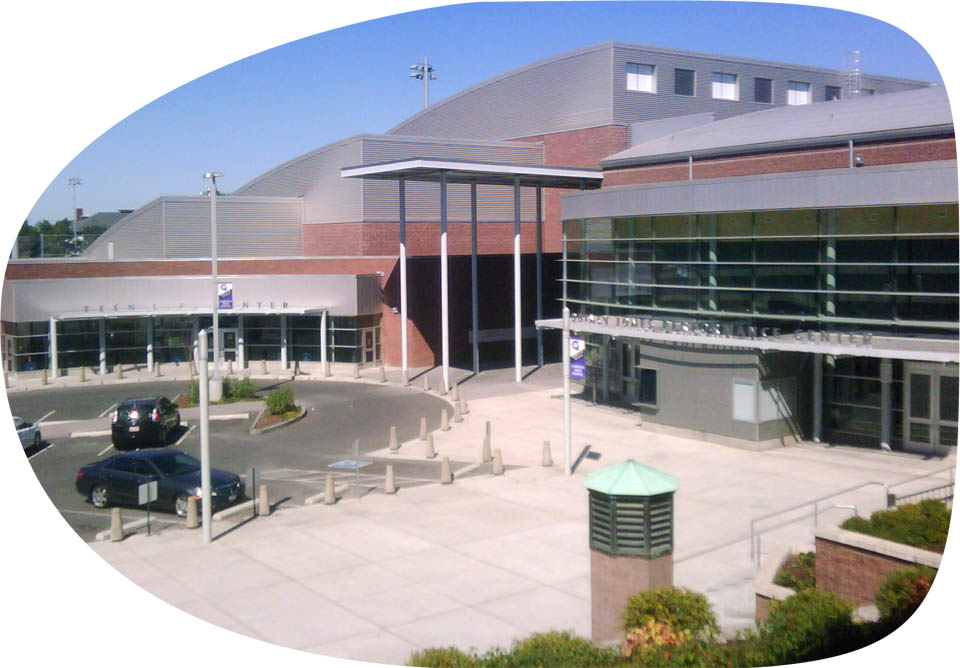
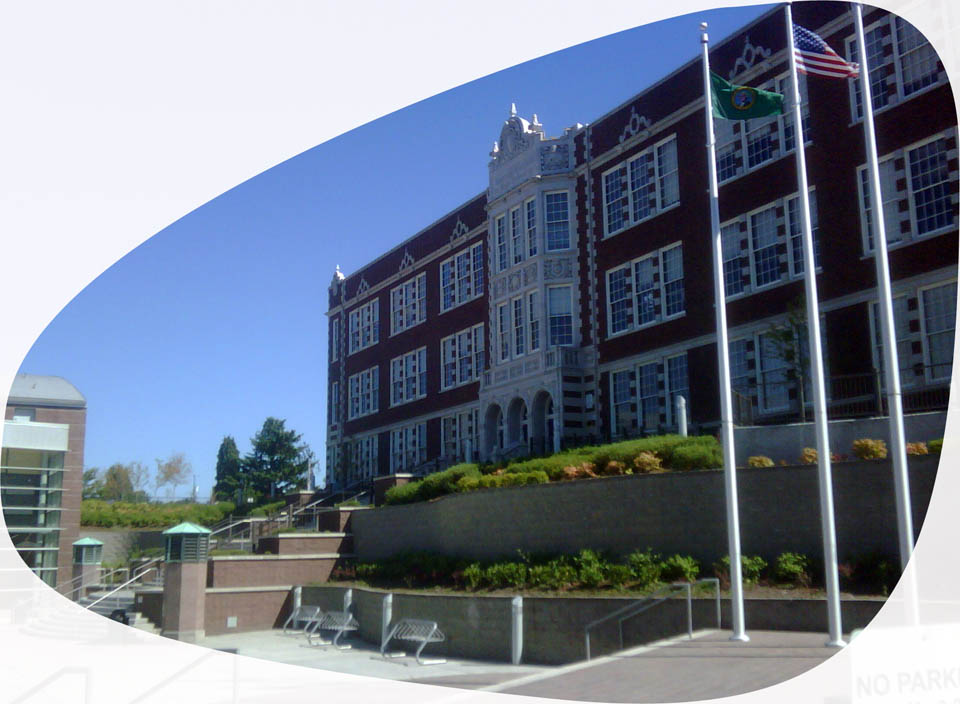
3. Mt. Rainer. Again, we've had beautiful weather on this trip.
And the Pacific Northwest has really shown off. We splurged a little on
the accommodations in Seattle and stayed in a hotel downtown that has a great
view from our room of Mt. Rainier on one side, and the Puget Sound and the
Olympic Mountains on the other. See attached pics. But, Rainier
shows off everywhere in the city, from the lawn at UW, to the many vantage
points off Rainier Highway, to the vistas across Lake Washington (See photo
taken on public dock, not far from Bill Gates' home on Lake Washington).
Very, very cool. (click on photos below for full size image)
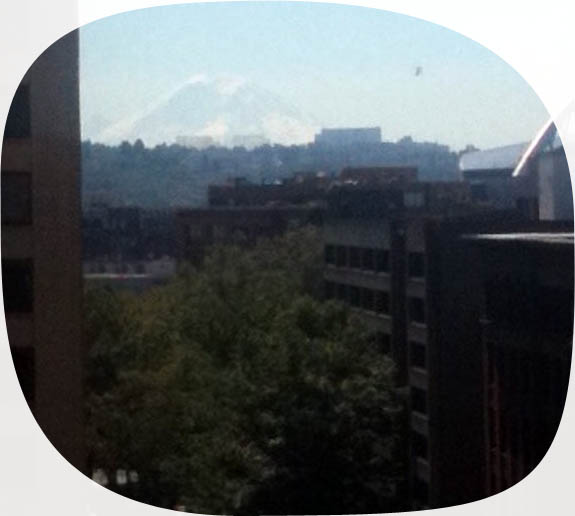
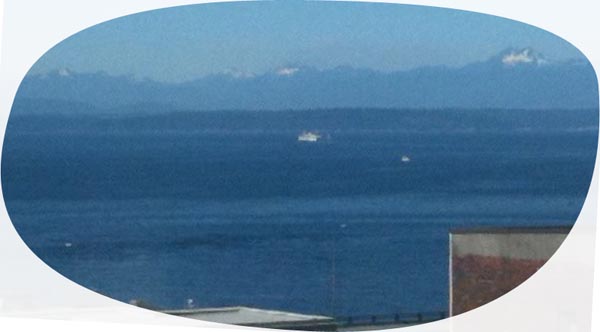

We head home this afternoon. To the Prairie.
Terry
Note: We managed (again) to go on vacation without a working camera. So all
the shots are taken from the IPhone.
 One of the reasons we chose this place is that they promote their scuba
diving program. That's right, scuba diving in the Pacific Northwest.
As a kid from Florida, there's a certain cognitive dissonance to the idea of
jumping in water in places where it snows in the winter -- for example, we don't
dive in Chicago. But, hey, we're adventurous so we figured we'd give it a
shot.
One of the reasons we chose this place is that they promote their scuba
diving program. That's right, scuba diving in the Pacific Northwest.
As a kid from Florida, there's a certain cognitive dissonance to the idea of
jumping in water in places where it snows in the winter -- for example, we don't
dive in Chicago. But, hey, we're adventurous so we figured we'd give it a
shot.



